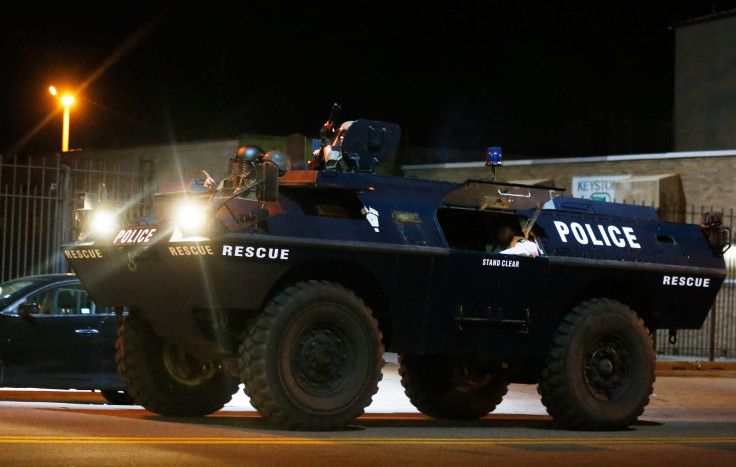Baltimore Riots 2015: Police Disperse Aggressive Crowd, Enforce Citywide Curfew After Standoff

Within two hours after a citywide curfew went into effect, an aggressive crowd in downtown Baltimore had largely dispersed, following a hostile standoff with law enforcement Tuesday night. The group had been growing in size and frustration at North and Pennsylvania avenues since early evening, police said.
Law enforcement officials used bull horns at 10 p.m. across the city to announce the start of the emergency curfew, which Mayor Stephanie Rawlings-Blake had enacted. But the crowd blocked roadways and refused to leave the street.
Some members of the crowd threw items at officers and while others broke away to start fires outside a nearby library. Police deployed pepper powder at the aggressive group and urged them to vacate the area. There were reports some people left the scene while others scattered off into other streets and alleyways in the city.
An International Business Times reporter at the scene said there was a large media presence with the group. Rioters threw rocks and plastic water bottles at police, who fired back with tear gas canisters and other non-lethal projectiles.
Cops throwing tear gas and protesters thrown it back. Choking right now. #BaltimoreUprising
- Howard Koplowitz (@HowardKoplowitz) April 29, 2015Empty tear gas canister that was lobbed. #BaltimoreUprising pic.twitter.com/nJx57budws
- Howard Koplowitz (@HowardKoplowitz) April 29, 2015Overall, police tactics appeared organized and officers maintained discipline. They moved forward in a line, stopping and starting, gradually pushing crowds back out of the main square. Some community leaders and citizens also encouraged people to go home, interposing themselves between the lines of police and the large crowds.
The Baltimore police commissioner said 10 people were arrested Tuesday night. But it appeared the police priority was to maintain calm and order, rather than immediately making arrests for violating the curfew, which might have only increased tensions.
For the next seven days, the curfew will begin at 10 p.m. and end at 5 a.m. Credentialed members of the media, medical emergencies and people going to and from work will be exempt from the emergency curfew. Baltimore Police Commissioner Anthony Batts could additionally impose a 24-hour juvenile curfew if necessary. City youth have played a violent role in Baltimore’s riots since Freddie Gray, 25, died in police custody earlier this month.
“They’re old enough to know better,” Batts said during a press conference outside police headquarters earlier Tuesday. “But they’re still kids, so we had to take that into account.”
Some people have protested peacefully, calling for a change in the culture of the Baltimore Police Department and law enforcement nationwide following a string of police-involved deaths across the country in the past year. But rioters looted business and burned buildings in downtown Baltimore Monday night, leaving scenes of devastation and destruction for communities by sunrise. Residents helped business owners clean up the ruin Tuesday, while community leaders showed support for Rawlings-Blake and Maryland law enforcement.
“We understand quite clearly that things need to change in Baltimore city, but what we saw was not reflective of the majority of the city,” said Mark Washington, executive director of Coldstream-Homestead Montebello Community Corporation. “Individuals took advantage of a situation and used it for their own cause.”
While the first night of the curfew was largely non-violent, it's unclear how the coming days and nights will play out. The underlying issues that provoked Monday's riots remain.
© Copyright IBTimes 2024. All rights reserved.





















